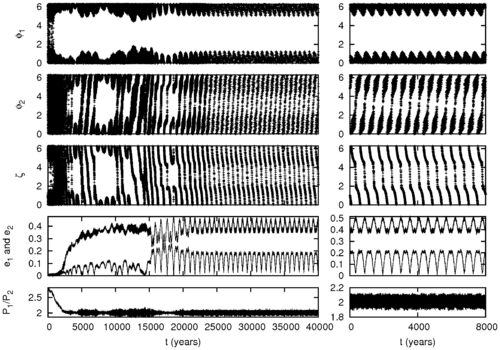HD 128311
| Observation data Epoch J2000 Equinox J2000 | |
|---|---|
| Constellation | Boötes |
| Right ascension | 14h 36m 00.56s[1] |
| Declination | +09° 44′ 47.5″[1] |
| Apparent magnitude (V) | 7.51 |
| Characteristics | |
| Spectral type | K0V |
| U−B color index | 0.78 |
| B−V color index | 0.99 |
| Variable type | BY Dra[2] |
| Astrometry | |
| Radial velocity (Rv) | -9.6 ± 0.4 km/s |
| Proper motion (μ) | RA: 204.74 ± 0.74[1] mas/yr Dec.: -249.98 ± 0.61[1] mas/yr |
| Parallax (π) | 60.60 ± 0.83[1] mas |
| Distance | 53.8 ± 0.7 ly (16.5 ± 0.2 pc) |
| Absolute magnitude (MV) | 8.5 |
| Details | |
| Mass | 0.8 M☉ |
| Radius | 0.73 R☉ |
| Luminosity | 0.221 L☉ |
| Surface gravity (log g) | 41.9 g cgs |
| Temperature | 4965 K |
| Metallicity | 108% |
| Age | 0.39 Gyr |
| Equatorial [ g ] | 411 m/s2 |
| Other designations | |
| Database references | |
| SIMBAD | data |
| ARICNS | data |
| Data sources: | |
| Hipparcos Catalogue, CCDM (2002), Bright Star Catalogue (5th rev. ed.) | |
HD 128311 or HN Boötis is an orange main-sequence star located approximately 54 light-years away in the constellation of Boötes. Two extrasolar planet candidates have been detected in orbit around this star.
Planetary system
In 2002, the discovery of the planet HD 128311 b was announced by Paul Butler.[3] In 2005, the discovery of a second planet HD 128311 c was announced by Steve Vogt.[4]
Most likely, the system has been formed in a very turbulent disc.[5] The authors were able to show with both analytic and numerical models that certain libration modes are readily excited by turbulence. It was initially thought that the system could have been resulted from planet planet scattering, but this is rather unlikely.

| Companion (in order from star) |
Mass | Semimajor axis (AU) |
Orbital period (days) |
Eccentricity | Inclination | Radius |
|---|---|---|---|---|---|---|
| b | >2.18 ± 0.22 MJ | 1.099 ± 0.04 | 458.6 ± 6.8 | 0.25 ± 0.10 | — | — |
| c | >3.21 ± 0.30 MJ | 1.76 ± 0.13 | 928.3 ± 18 | 0.17 ± 0.09 | — | — |
See also
References
- 1 2 3 4 5 van Leeuwen, F. (2007). "Validation of the new Hipparcos reduction". Astronomy and Astrophysics. 474 (2): 653–664. Bibcode:2007A&A...474..653V. arXiv:0708.1752
 . doi:10.1051/0004-6361:20078357. Vizier catalog entry
. doi:10.1051/0004-6361:20078357. Vizier catalog entry - ↑ Samus, N. N.; Durlevich, O. V.; et al. (2009). "VizieR Online Data Catalog: General Catalogue of Variable Stars (Samus+ 2007-2013)". VizieR On-line Data Catalog: B/gcvs. Originally published in: 2009yCat....102025S. 1. Bibcode:2009yCat....102025S.
- ↑ Butler, R. Paul; et al. (2003). "Seven New Keck Planets Orbiting G and K Dwarfs". The Astrophysical Journal. 582 (1): 455–466. Bibcode:2003ApJ...582..455B. doi:10.1086/344570.
- 1 2 Vogt, Steven S.; et al. (2005). "Five New Multicomponent Planetary Systems". The Astrophysical Journal. 632 (1): 638–658. Bibcode:2005ApJ...632..638V. doi:10.1086/432901.
- ↑ Rein, Hanno; Papaloizou, J. C. B. (2009). "On the evolution of mean motion resonances through stochastic forcing: Fast and slow libration modes and the origin of HD128311". Astronomy and Astrophysics. 497: 595–609. Bibcode:2009A&A...497..595R. arXiv:0811.1813
 . doi:10.1051/0004-6361/200811330.
. doi:10.1051/0004-6361/200811330.
- "Notes for star HD 128311". The Extrasolar Planets Encyclopaedia. Retrieved 2008-08-18.
External links
- GJ 3860
- Extrasolar Planet Interactions by Rory Barnes & Richard Greenberg, Lunar and Planetary Lab, University of Arizona
- Image HD 128311
Coordinates: ![]() 14h 36m 00.5607s, +09° 44′ 47.466″
14h 36m 00.5607s, +09° 44′ 47.466″